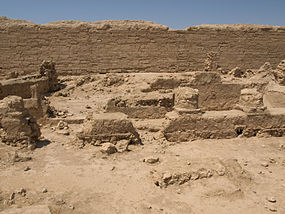- Dura-Europos synagogue
-
Dura-Europos Synagogue 
Courtyard, western porch and prayer hall Coordinates 34°44′51″N 40°43′38″E / 34.7474°N 40.7272°E Site notes Condition ruin The Dura-Europos synagogue (or "Dura Europas", "Dura Europos" etc) is an ancient synagogue uncovered at Dura-Europos, Syria, in 1932. The last phase of construction was dated by an Aramaic inscription to 244 CE, making it one of the oldest synagogues in the world. It is unique among the many ancient synagogues that have emerged from archaeological digs as it was preserved virtually intact, and it has extensive figurative wall-paintings. These frescoes are now displayed in the National Museum of Damascus.
Before the final Persian assault on the town, parts of the synagogue which abutted the main city wall were apparently requisitioned and filled with sand as a defensive measure. This helped its survival in such good condition.
Contents
Wall-paintings
Because of the paintings adorning the walls, the synagogue was at first mistaken for a Greek temple. The synagogue contains a forecourt and house of assembly with painted walls depicting people and animals, and a Torah shrine in the western wall facing Jerusalem. The paintings cover the walls of the main "Assembly Room", using three levels of pictures over a dado frieze of symbols in most places, reaching a height of about 7 metres. The scenes depicted are drawn from the Hebrew Bible and include many narrative scenes, and some single figure "portraits"—58 scenes in total, probably representing about 60% of the original number. They include the Sacrifice of Isaac and other Genesis stories, Moses receiving the Tablets of the Law, Moses leading the Hebrews out of Egypt, the visions of Ezekiel, and many others. The Hand of God motif is used to represent divine intervention in a scene. Scholars cannot agree on the subjects of some scenes, because of damage, or the lack of comparative examples.
Stylistically they are provincial versions of contemporary Graeco-Roman style and technique; several different artists seem to have worked on them. Technically they are not fresco (paint fused into wet plaster) but tempera over plaster. Earlier parts of the building have decorative painting with no figures. Some of the paintings have figures whose eyes have been scratched out, especially those in Persian costume. (See the figure on the white horse in the picture at right.)
 Scenes from the Book of Esther from the Dura-Europos synagogue, 244 CE
Scenes from the Book of Esther from the Dura-Europos synagogue, 244 CE
Scholars think the paintings were used as an instructional display to educate and teach the history and laws of the religion. Some think that this synagogue was painted in order to compete with the many other religions practiced in Dura Europos; the new (and considerably smaller) Christian church (Dura-Europos church) appears to have opened shortly before the surviving paintings were begun in the synagogue. The large-scale pictorial art in the synagogue came as a surprise to scholars, although they already suspected that there was a tradition of Jewish narrative religious art at this period, which had all been lost, leaving only traces in later Christian art. The discovery of the synagogue helps to dispel narrow interpretations of Judaism's historical prohibition of visual images.
See also
References
- Hachlili, Rachel. Ancient Jewish Art and Archaeology in the Diaspora, Part 1, BRILL, 1998, ISBN 9004108785, 9789004108783, Google books
- Kessler, Edward in Sawyer, John FA. The Blackwell companion to the Bible and culture, Wiley-Blackwell, 2006, ISBN 1405101369, 9781405101363 Google books
External links
- Synagogue frescoes at EIKON Image Database for Biblical Studies, Yale Divinity School.
Categories:- Synagogues in Syria
- Fresco paintings
- 3rd-century architecture
- Ancient synagogues
- Jewish Syrian history
- Roman Empire art
Wikimedia Foundation. 2010.

